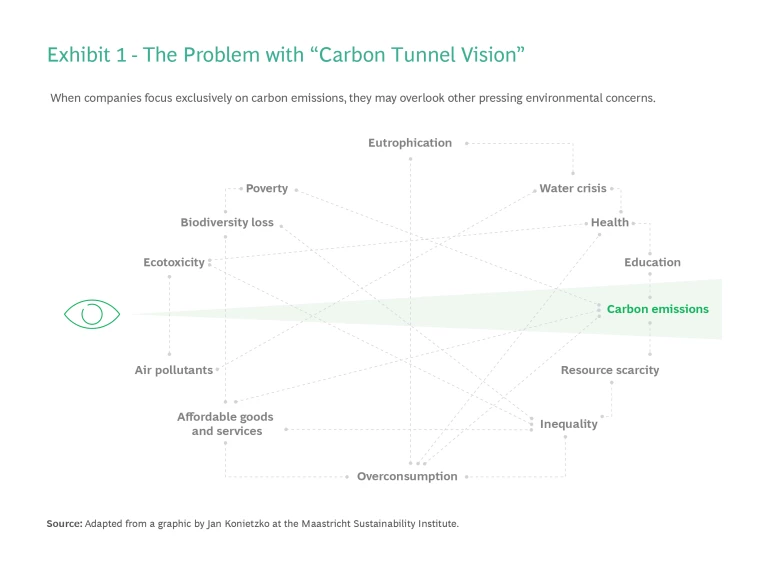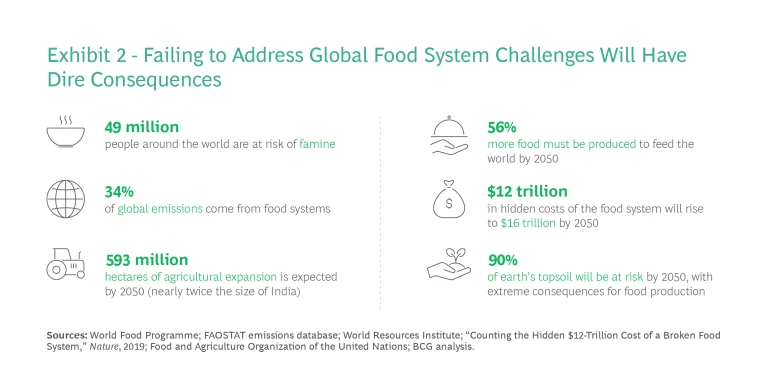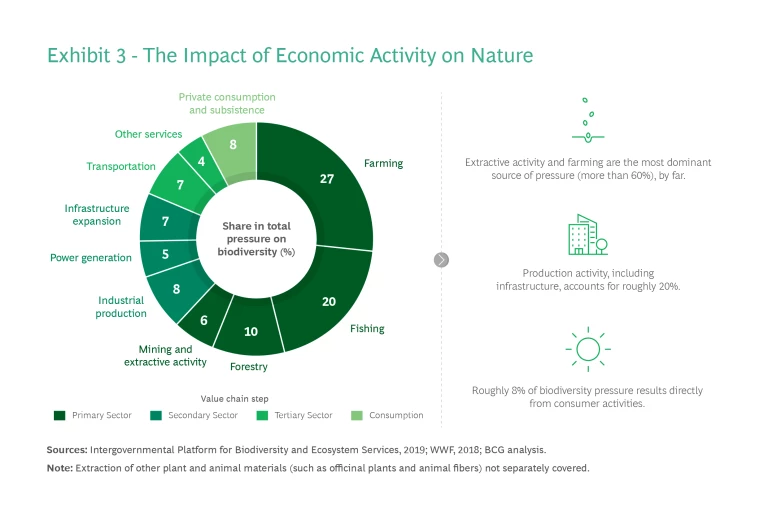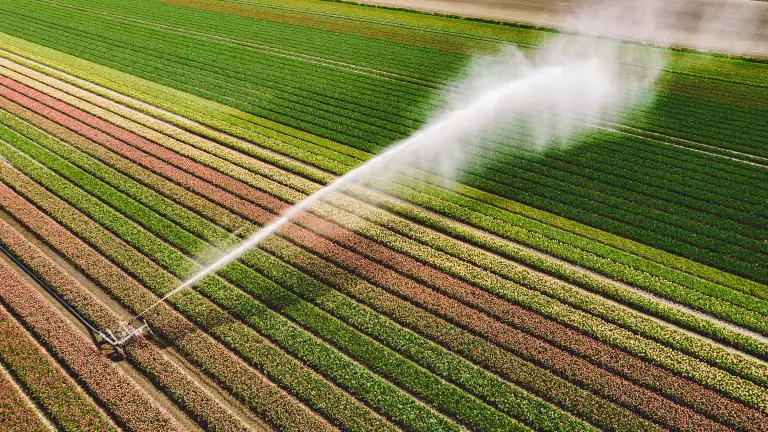Over the past decade, decarbonization has become a global rallying cry, giving leaders a common language to tackle climate change by establishing relatively clear, agreed-upon emissions targets. While these efforts have advanced carbon reduction goals globally—though not as fast as everyone had hoped—this singular focus on emissions has led to “carbon tunnel
This approach has meant that while companies and industries have ramped up efforts to optimize for net zero emissions, other sustainable development goals and environmental threats have not seen the same momentum. As a result, businesses may overlook the ways in which the earth’s
climate
and natural resources are inextricably intertwined—and miss the opportunity to recognize nature as core to addressing the most pressing environmental

Leaders across various industries have already embraced this paradigm shift that recognizes the inseparable relationship between nature and climate, and they are aligning their strategies accordingly. Indeed, climate and decarbonization represent just one of the nine planetary boundaries that must be addressed to ensure a safe, just, and sustainable planet for future generations. We are also facing a severe nature crisis including challenges such as biodiversity loss, natural resource scarcity, large-scale environmental degradation, and ecosystem collapse. Many sectors are already feeling the effects—perhaps none more than the global food system . (See Exhibit 2.)

The loss of our natural resources affects not only our delicate food system but also our global population. The food system is tightly interlinked with human activity, and the resulting environmental effects of that have cascading socioeconomic impacts, exposing deep-rooted inequalities. To create a truly sustainable future, we must embrace a holistic perspective that ties decarbonization targets with nature-positive ones. (See “What Are Nature-Positive Targets?”)
What Are Nature-Positive Targets?
In this article, we address the dangers of carbon tunnel vision, highlight the critical role that a nature-positive approach can play in strengthening the global food system, and offer a set of recommendations to help companies understand how their net zero efforts can also support a nature-positive future.
To create a truly sustainable future, we must embrace a holistic perspective that ties decarbonization targets with nature-positive ones.
Food Systems Under Pressure
The need to create a sustainable food system while feeding a growing world population is becoming more urgent every year. In the second half of the twentieth century, the green revolution bolstered global food security—and the hard work of farmers around the world has kept us fed through different global crises—but it also massively increased emissions and pushed some natural ecosystems to the brink of collapse .
For example, intensive farming practices such as continuous monoculture and agrochemical application have led to deforestation and soil degradation, which in turn increase the risk of erosion and habitat loss. Likewise, the expansion of irrigation systems has depleted water resources in some regions, rendering certain areas unsuitable for agriculture. Given that 75% of food crops —including vegetables, almonds, and coffee—rely on healthy soil, water, and pollination, continuing along this path has serious implications for the global food system.
Pioneers in the food industry
, building on decades of research and Indigenous knowledge, provide sparks of hope. But it’s clear that we are not moving fast enough. We need to catalyze meaningful change by thinking through a broader range of environmental goals. Some of the shifts needed include:
- Net Zero to Nature Positive. To strengthen the global food system, companies must look to embrace nature-positive solutions in addition to carbon reduction. If we only track carbon emissions, for example, then a company’s ability to release toxic waste into local waterways may be left to local regulations, which can be inconsistent at best. Similarly, when companies focus on reforestation to fight climate change but they plant commercial, non-native species that reduce biodiversity and speed extinctions, we are literally missing the forest for the trees.
- Carbon Targets to Nature Targets. In addition to carbon reduction targets, we also need science-based nature targets, which are actions that companies can take to focus on protecting the connectivity and integrity of ecosystems. The goal is to combat biodiversity loss, preserve all species of plants, animals, and microorganisms (as well as the genetic diversity within these species), halt and reverse land degradation, and protect freshwater ecosystems. It’s also critical that these targets are backed up by action plans.
- Climate Change Focus to Nature and Climate Interdependencies. We must adopt an approach that focuses on creating healthy and resilient ecosystems, understanding that nature plays a critical role in solving the climate crisis (and vice versa). The climate and nature agendas must work in tandem, considering solutions and outcomes that benefit the entire ecosystem.
So what can be done to ensure a sustainable future for the food system and protect the planet’s natural resources? To achieve widespread benefits, companies must embrace nature-based solutions.
The Nature Advantage
More than half the world’s total GDP is moderately or highly dependent on nature and what it provides—things many of us have taken for granted, such as clean water, intact forests, and healthy soil. The economic value of biodiversity and healthy ecosystems to society is even greater. Ecosystem services, such as food production, coastal protection, carbon storage, and water filtration, are worth an estimated $150 trillion per year. Failure to care for the ecosystem translates to a significant loss for the sector, up to $25 trillion yearly, endangering the productivity and resilience of the land, farmers’ livelihoods, and the food system as a whole. To put it succinctly, nature is critically important to the food value chain.
Failure to care for the ecosystem translates to a significant loss, up to $25 trillion yearly, endangering the land, farmers’ livelihoods, and the food system as a whole.
Yet the agriculture industry is the single biggest driver of biodiversity loss . (See Exhibit 3.) The world’s land and water resources are being exploited at unprecedented rates. Conventional agricultural systems and supply chains are complex and entrenched, and farmers lack the necessary support to overcome the cost and risk of switching to more sustainable practices.

Regenerative agriculture offers an important step forward for the industry. It promotes above- and below-ground carbon sequestration and reduces greenhouse gas emissions, while also protecting biodiversity in and around farms, improving water retention in the soil, improving nutrient use efficiency, and supporting farmers’ livelihoods. A recent BCG study in collaboration with One Planet Business for Biodiversity and the World Business Council for Sustainable Development shows that farmers are most likely to adopt regenerative agriculture for two reasons: to reduce costs and to improve soil health. Notably, only 5% of farmers cited carbon sequestration as their primary reason for adopting regenerative agriculture. In other words, a nature-positive solution that improves soil health may be more enticing to farmers than a net zero solution that reduces carbon emissions.
A nature-positive solution that improves soil health may be more enticing to farmers than a net zero solution that reduces carbon emissions.
The benefits of nature-positive solutions are amplified when stakeholders collaborate and adopt comprehensive strategies at the landscape level (rather than within a single farm). For example, farmers can join forces to protect all local pollinators or collaborate to maintain the integrity of nearby bodies of water. By considering the ways agricultural activities affect the overall ecosystem—as well as local and Indigenous communities—and then managing natural resources in ways that achieve social, economic, and environmental objectives, agricultural communities can build a much more sustainable food system. By implementing landscape-level actions, farmers and companies are also able to engage a broader set of stakeholders, each interested in different areas of focus that can unlock new opportunities for collaboration in areas such as transition finance.
Incidentally, numerous other industries can reap the rewards of combining net zero targets with nature-positive ones. (See “How Pharma Can Benefit from a Nature-Positive Approach.”) And there’s no time to lose. Whether companies are in the early stages of a sustainability strategy or have already taken bold steps to reduce their carbon footprint, it’s time to think bigger by including nature and biodiversity in their plans.
How Pharma Can Benefit from a Nature-Positive Approach
- Pharma companies need pure water for manufacturing medications. The decline in water quality is creating ongoing water purification challenges and increasing the cost of this critical step in their supply chains.
- One-third of medical treatments are based on natural products, including common medicines like aspirin, which originally derived from the bark of willow trees. The decline of natural ecosystems is disrupting important supply chains that pharma companies depend upon.
Five Actions to Prioritize Nature
Most greenhouse gas emissions and nature loss are a direct result of business-related activities. But this also means that businesses have the power to reverse the damage if they work together. To tackle the challenges in our global food system, an integrated and holistic approach that addresses both climate and nature is critical.
Here are several steps companies can take to protect the world’s natural resources—the essential assets that enable their businesses to thrive:
- Analyze and quantify nature-related risks to the business, and learn where vulnerabilities exist. Understand where your business is vulnerable to nature-related risks, such as resource scarcity, desertification, ecosystem degradation, and biodiversity loss. Assess your company’s impact on water quality, including runoff and its contribution to pollution, depletion, or degradation. Then look for ways to combine carbon targets with nature targets, prioritizing initiatives in areas where resources are constrained and the business is most vulnerable. Without understanding the risks, companies are acting in the dark and may miss seeing ways their supply chains could be vulnerable to extreme disruption.
- Identify interdependencies, and ensure that climate and nature agendas work together. Climate and nature are inextricably linked. Much of the pressure on biodiversity stems from climate change. And biodiversity loss significantly accelerates climate change when natural sources of carbon sequestration are destroyed. By understanding these interdependencies, companies can become leaders in sustainability and value creation and design initiatives that consider both climate and nature from the outset, instead of needing to retrofit initiatives at a higher cost later on. Conduct a materiality assessment to identify your company’s nature-related impacts and dependencies and take care to ensure that climate action benefits nature (and vice versa).
- Assess risks to nature at the product level. Look for ways to transform or create new products that can reduce nature loss and contribute positively. Invest in products that are good for the environment and deliver a new source of competitive advantage. For example, companies could source product ingredients that are grown using biodiverse crop rotations instead of monocultures.
- Develop an ecosystem strategy. Connect with the right value chain partners, including competitors (in a precompetitive environment) to ensure that natural resources are being protected. At the same time, take steps to enhance your own supply chain transparency and assess the sustainability risk to suppliers of threats such as land and water use, pollution, greenhouse gases, and invasive species.
- Develop targets and an actionable roadmap. Right now, the climate agenda and the nature agenda are not well integrated, but standards for disclosure and action on the nature transition are coming. The Science Based Targets Network, launched in 2020, extends the concept of science-based targets from climate to nature. In 2021, the Taskforce on Nature-Related Financial Disclosures was formed to extend climate-related risk reporting and address a broader range of environmental exposures. Using these frameworks, companies can set clear targets and create roadmaps to guide their strategy.
In its 2023 report, the Intergovernmental Panel on Climate Change said that “there is a rapidly closing window of opportunity to secure a livable and sustainable future for all.” Increasingly, extreme climate-related weather events have exposed millions of people to acute food and water insecurity—and it will only get worse over time.
The climate, nature, and biodiversity crises have reached a point where humanity can no longer afford to watch and wait.
The climate, nature, and biodiversity crises have reached a point where humanity can no longer afford to watch and wait. To achieve a just and sustainable food system, organizations must assess the most pressing climate and nature challenges within their unique context, identify the areas where they can make the greatest impact, and seize opportunities to act both individually and in collaboration with the larger ecosystem in ways that deliver maximum effect and avoid further damage.
We can learn from nature: when an old tree dies in the forest, sunlight reaches places that were previously covered in shade. In these newly illuminated spaces, a burst of new life emerges. A change in context provides opportunities. Companies that prioritize nature, in addition to carbon reduction, can position themselves in the sunlight to emerge as winners in the effort to protect our planet—and become the next generation of sustainability leaders.









